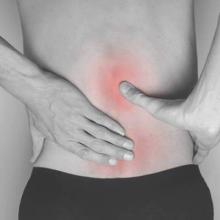NATIONAL HARBOR, MD. – Before considering treatments and surgical options to mitigate lower back pain, physicians should counsel affected patients that quitting smoking is a more effective – and considerably more affordable – means of finding relief.
At the annual meeting of the American Academy of Pain Management, Dr. Brian White spoke at length about the debilitating effects of both smoking and weight on bone and muscle pain, and how the key to alleviating that pain is to cut out the former and bring down the latter.
“When we think of multiple medical conditions associated with smoking, we don’t really think of musculoskeletal issues, but they are strongly associated with smoking,” explained Dr. White, an interventional physiatrist with the Bassett Healthcare Network in Cooperstown, N.Y.
Dr. White began by talking about the effects of smoking, extensively citing a 2010 study that examined the pathophysiology between smoking and pain. Findings indicated that long-term smoking causes receptor desensitization, creating the perception in smokers that a relatively small amount of pain is severe (Anesthesiology. 2010;113[4]:977-92).
Furthermore, smoking deprivation – either caused by a longer-than-usual amount of time between periods of intake or attempts to quit – causes patients to have shorter pain latency. Structural damage caused by smoking can lead to increased risk of osteoporosis, lumbar disk disease, and impaired bone and wound healing, along with impaired oxygen delivery, the investigators concluded in the 2010 study.
Several other studies confirm these findings, said Dr. White, including a pair concluding that smoking is associated with higher lifetime risk of musculoskeletal pain (Ann Rheum Dis. 2003;62[1]:33-6), as well as higher intensity of pain (Scand J Rheumatol. 1997;26[1]:49-54).
Additionally, smoking can alter the effectiveness of opioids prescribed for pain management. “Smokers have higher pain scores and higher opioid use, but lower serum hydrocodone levels,” he said. “This may suggest an up-regulation of the metabolic pathway for morphine.”
Regarding lower back pain, smoking has been found to cause nicotine-associated disk degeneration, according to a 2013 study (Muscles Ligaments Tendons J. 2013;3[2]:63-9). A separate study calculated odds ratios for smokers developing lower back pain as 1.49 for those simply “seeking care,” 1.79 for those experiencing chronic lower back pain, and 2.14 for smokers experiencing severe lower back pain (Am J Med. 2010;123[1]:87 e7-e35).
The most telling study, however, was a 2012 prospective review of 5,322 patients, which found that patients who never smoked experienced significantly less pain than those who did, and that patients who quit smoking over the course of their pain management treatment experienced better outcomes than patients who continued smoking (J Bone Joint Surg Am. 2012;94[23]:2161-6).
“As a group, those who continued to smoke during [treatment] had no clinically important improvement in pain,” explained Dr. White.
Dr. White did not report any relevant financial disclosures.


